英语-倒装(全部倒装和部分倒装)学习资料
- 格式:ppt
- 大小:182.50 KB
- 文档页数:13
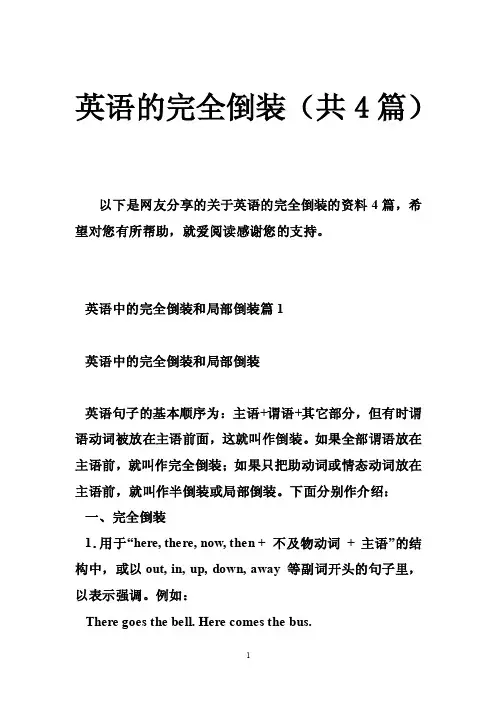
英语的完全倒装(共4篇)以下是网友分享的关于英语的完全倒装的资料4篇,希望对您有所帮助,就爱阅读感谢您的支持。
英语中的完全倒装和局部倒装篇1英语中的完全倒装和局部倒装英语句子的基本顺序为:主语+谓语+其它部分,但有时谓语动词被放在主语前面,这就叫作倒装。
如果全部谓语放在主语前,就叫作完全倒装;如果只把助动词或情态动词放在主语前,就叫作半倒装或局部倒装。
下面分别作介绍:一、完全倒装1.用于“here, there, now, then + 不及物动词+ 主语”的结构中,或以out, in, up, down, away 等副词开头的句子里,以表示强调。
例如:There goes the bell. Here comes the bus.Now comes your turn. Out went the teacher and the children. Away he went. Up he rose.2.用于“there be”的结构中,例如:There were many boys and girls on the playground just now.There will be a new station near our school.3.当介词短语或地点状语放在句首作状语时,例如:North of the city lies/is a new airport.From the valley came a frightening sound with some cries. 4.表语放句首时倒装结构为:“表语+连系动词+主语”,例如:Present at the meeting is our English teacher.Gone are the days when we had a good time at the mountain village.In the middle of the room stand twodesks and some chairs for the party.5.当“so/such… that”结构中的so 或such 位于句首时,例如:So beautiful was she that many men would like to dance with her at the party.Such an honest boy is he that he gave back the change to me after shopping.6.用于so, nor, neither开头的句子,表示重复前面的内容,原句的谓语应与前面的谓语动词的时态、形式等相一致。
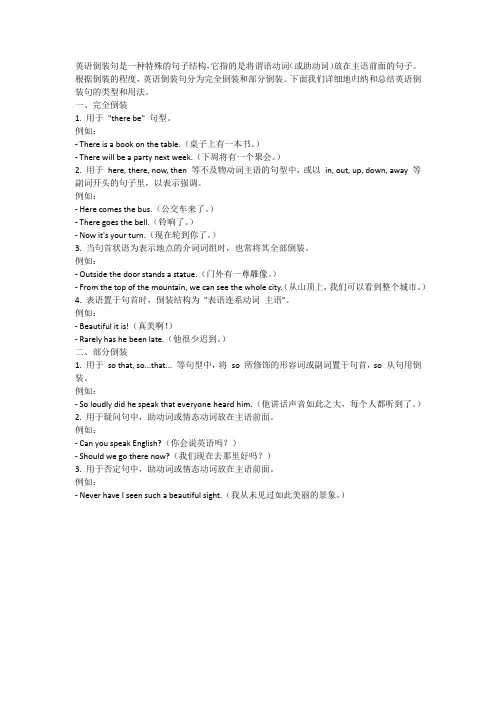
英语倒装句是一种特殊的句子结构,它指的是将谓语动词(或助动词)放在主语前面的句子。
根据倒装的程度,英语倒装句分为完全倒装和部分倒装。
下面我们详细地归纳和总结英语倒装句的类型和用法。
一、完全倒装1. 用于"there be" 句型。
例如:- There is a book on the table.(桌子上有一本书。
)- There will be a party next week.(下周将有一个聚会。
)2. 用于here, there, now, then 等不及物动词主语的句型中,或以in, out, up, down, away 等副词开头的句子里,以表示强调。
例如:- Here comes the bus.(公交车来了。
)- There goes the bell.(铃响了。
)- Now it's your turn.(现在轮到你了。
)3. 当句首状语为表示地点的介词词组时,也常将其全部倒装。
例如:- Outside the door stands a statue.(门外有一尊雕像。
)- From the top of the mountain, we can see the whole city.(从山顶上,我们可以看到整个城市。
)4. 表语置于句首时,倒装结构为"表语连系动词主语"。
例如:- Beautiful it is!(真美啊!)- Rarely has he been late.(他很少迟到。
)二、部分倒装1. 用于so that, so...that... 等句型中,将so 所修饰的形容词或副词置于句首,so 从句用倒装。
例如:- So loudly did he speak that everyone heard him.(他讲话声音如此之大,每个人都听到了。
)2. 用于疑问句中,助动词或情态动词放在主语前面。
例如:- Can you speak English?(你会说英语吗?)- Should we go there now?(我们现在去那里好吗?)3. 用于否定句中,助动词或情态动词放在主语前面。
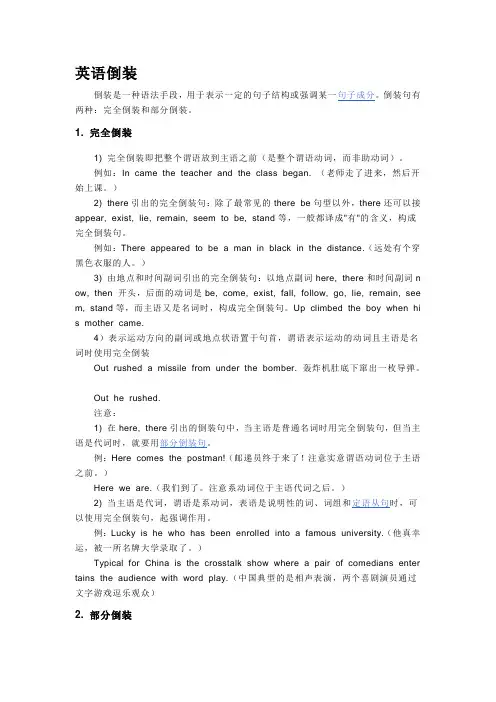
英语倒装倒装是一种语法手段,用于表示一定的句子结构或强调某一句子成分。
倒装句有两种:完全倒装和部分倒装。
1. 完全倒装1) 完全倒装即把整个谓语放到主语之前(是整个谓语动词,而非助动词)。
例如:In came the teacher and the class began. (老师走了进来,然后开始上课。
)2) there引出的完全倒装句:除了最常见的there be句型以外,there还可以接appear, exist, lie, remain, seem to be, stand等,一般都译成"有"的含义,构成完全倒装句。
例如:There appeared to be a man in black in the distance.(远处有个穿黑色衣服的人。
)3) 由地点和时间副词引出的完全倒装句:以地点副词here, there和时间副词n ow, then 开头,后面的动词是be, come, exist, fall, follow, go, lie, remain, see m, stand等,而主语又是名词时,构成完全倒装句。
Up climbed the boy when hi s mother came.4)表示运动方向的副词或地点状语置于句首,谓语表示运动的动词且主语是名词时使用完全倒装Out rushed a missile from under the bomber. 轰炸机肚底下窜出一枚导弹。
Out he rushed.注意:1) 在here, there引出的倒装句中,当主语是普通名词时用完全倒装句,但当主语是代词时,就要用部分倒装句。
例:Here comes the postman!(邮递员终于来了!注意实意谓语动词位于主语之前。
)Here we are.(我们到了。
注意系动词位于主语代词之后。
)2) 当主语是代词,谓语是系动词,表语是说明性的词、词组和定语从句时,可以使用完全倒装句,起强调作用。
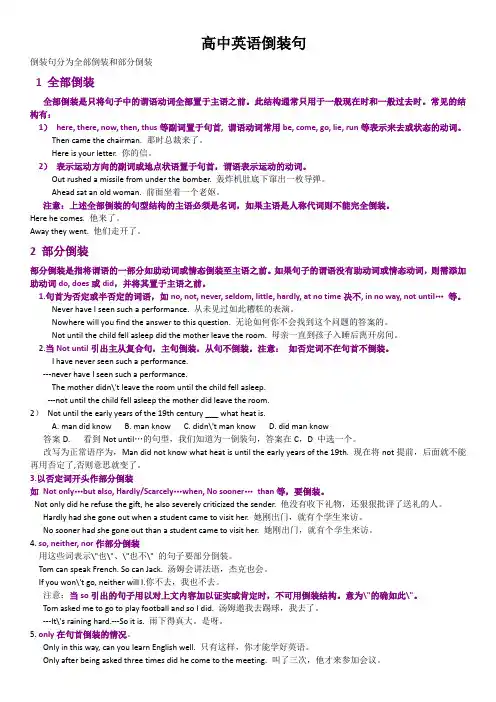
高中英语倒装句倒装句分为全部倒装和部分倒装1 全部倒装全部倒装是只将句子中的谓语动词全部置于主语之前。
此结构通常只用于一般现在时和一般过去时。
常见的结构有:1)here, there, now, then, thus等副词置于句首, 谓语动词常用be, come, go, lie, run等表示来去或状态的动词。
Then came the chairman. 那时总裁来了。
Here is your letter. 你的信。
2)表示运动方向的副词或地点状语置于句首,谓语表示运动的动词。
Out rushed a missile from under the bomber. 轰炸机肚底下窜出一枚导弹。
Ahead sat an old woman. 前面坐着一个老妪。
注意:上述全部倒装的句型结构的主语必须是名词,如果主语是人称代词则不能完全倒装。
Here he comes. 他来了。
Away they went. 他们走开了。
2 部分倒装部分倒装是指将谓语的一部分如助动词或情态倒装至主语之前。
如果句子的谓语没有助动词或情态动词,则需添加助动词do, does或did,并将其置于主语之前。
1.句首为否定或半否定的词语,如no, not, never, seldom, little, hardly, at no time决不, in no way, not until…等。
Never have I seen such a performance. 从未见过如此糟糕的表演。
Nowhere will you find the answer to this question. 无论如何你不会找到这个问题的答案的。
Not until the child fell asleep did the mother leave the room. 母亲一直到孩子入睡后离开房间。
2.当Not until引出主从复合句,主句倒装,从句不倒装。
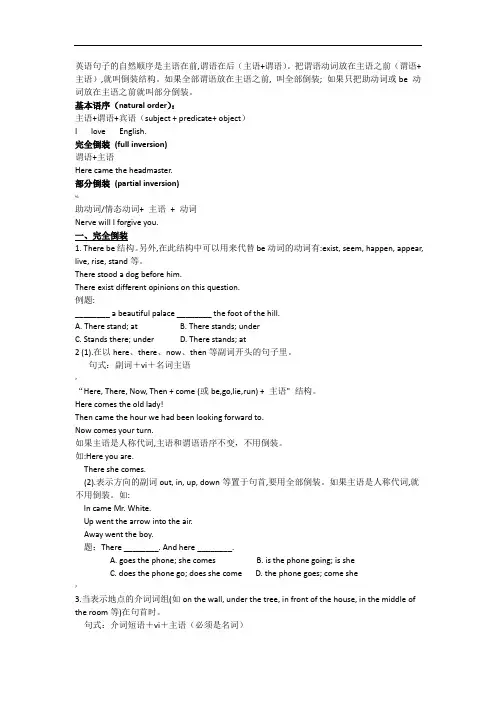
英语句子的自然顺序是主语在前,谓语在后(主语+谓语)。
把谓语动词放在主语之前(谓语+主语),就叫倒装结构。
如果全部谓语放在主语之前, 叫全部倒装; 如果只把助动词或be 动词放在主语之前就叫部分倒装。
基本语序(natural order):主语+谓语+宾语(subject + predicate+ object)I love English.完全倒装(full inversion)谓语+主语Here came the headmaster.部分倒装(partial inversion)%助动词/情态动词+ 主语+ 动词Nerve will I forgive you.一、完全倒装1. There be结构。
另外,在此结构中可以用来代替be动词的动词有:exist, seem, happen, appear, live, rise, stand等。
There stood a dog before him.There exist different opinions on this question.例题:________ a beautiful palace ________ the foot of the hill.A. There stand; atB. There stands; underC. Stands there; underD. There stands; at2 (1).在以here、there、now、then等副词开头的句子里。
句式:副词+vi+名词主语>“Here, There, Now, Then + come (或be,go,lie,run) + 主语" 结构。
Here comes the old lady!Then came the hour we had been looking forward to.Now comes your turn.如果主语是人称代词,主语和谓语语序不变,不用倒装。

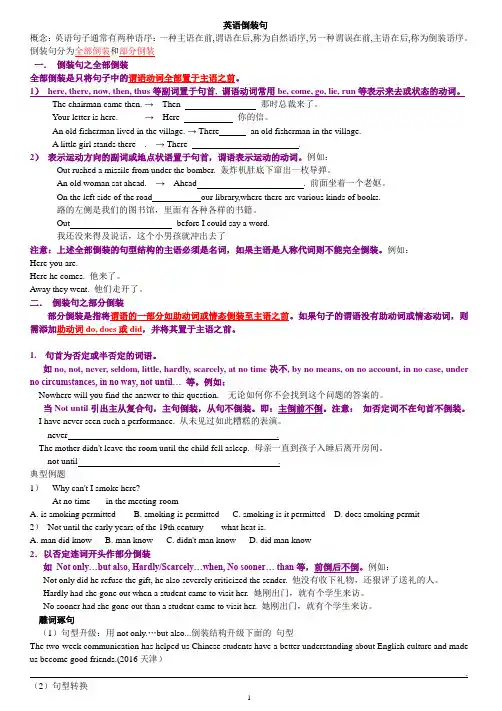
英语倒装句概念:英语句子通常有两种语序:一种主语在前,谓语在后,称为自然语序,另一种谓误在前,主语在后,称为倒装语序。
倒装句分为全部倒装和部分倒装一.倒装句之全部倒装全部倒装是只将句子中的谓语动词全部置于主语之前。
1)here, there, now, then, thus等副词置于句首, 谓语动词常用be, come, go, lie, run等表示来去或状态的动词。
The chairman came then. →Then 那时总裁来了。
Your letter is here. →Here 你的信。
An old fisherman lived in the village. → There an old fisherman in the village.A little girl stands there . → There .2)表示运动方向的副词或地点状语置于句首,谓语表示运动的动词。
例如:Out rushed a missile from under the bomber. 轰炸机肚底下窜出一枚导弹。
An old woman sat ahead. →Ahead . 前面坐着一个老妪。
On the left side of the road our library,where there are various kinds of books.路的左侧是我们的图书馆,里面有各种各样的书籍。
Out before I could say a word.我还没来得及说话,这个小男孩就冲出去了注意:上述全部倒装的句型结构的主语必须是名词,如果主语是人称代词则不能完全倒装。
例如:Here you are.Here he comes. 他来了。
Away they went. 他们走开了。
二.倒装句之部分倒装部分倒装是指将谓语的一部分如助动词或情态倒装至主语之前。
如果句子的谓语没有助动词或情态动词,则需添加助动词do, does或did,并将其置于主语之前。
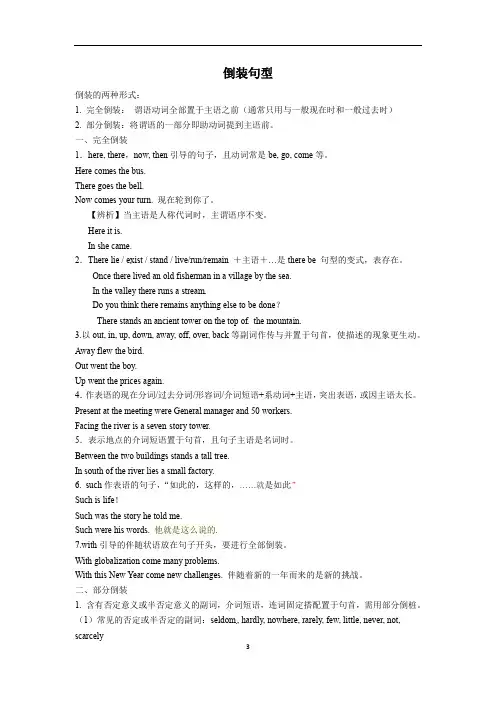
倒装句型倒装的两种形式:1. 完全倒装:谓语动词全部置于主语之前(通常只用与一般现在时和一般过去时)2. 部分倒装:将谓语的一部分即助动词提到主语前。
一、完全倒装1.here, there,now, then引导的句子,且动词常是be, go, come等。
Here comes the bus.There goes the bell.Now comes your turn. 现在轮到你了。
【辨析】当主语是人称代词时,主谓语序不变。
Here it is.In she came.2.There lie / exist / stand / live/run/remain +主语+…是there be 句型的变式,表存在。
Once there lived an old fisherman in a village by the sea.In the valley there runs a stream.Do you think there remains anything else to be done?There stands an ancient tower on the top of the mountain.3.以out, in, up, down, away, off, over, back等副词作传与并置于句首,使描述的现象更生动。
Away flew the bird.Out went the boy.Up went the prices again.4.作表语的现在分词/过去分词/形容词/介词短语+系动词+主语,突出表语,或因主语太长。
Present at the meeting were General manager and 50 workers.Facing the river is a seven-story tower.5.表示地点的介词短语置于句首,且句子主语是名词时。
Between the two buildings stands a tall tree.In south of the river lies a small factory.6.such作表语的句子,“如此的,这样的,……就是如此”Such is life!Such was the story he told me.Such were his words. 他就是这么说的.7.with引导的伴随状语放在句子开头,要进行全部倒装。
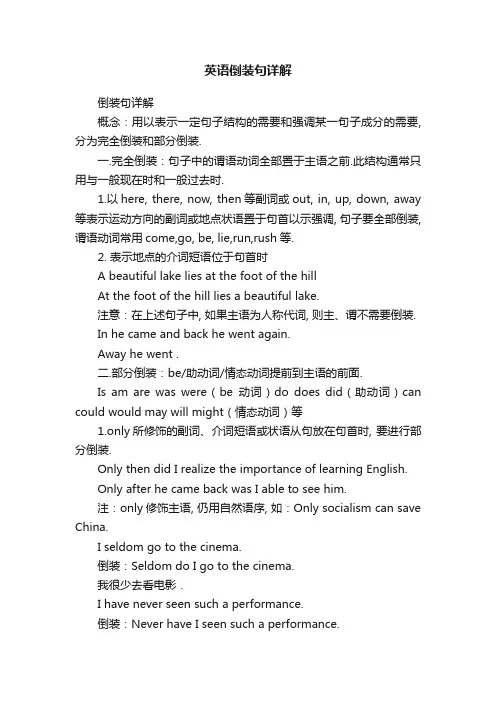
英语倒装句详解倒装句详解概念:用以表示一定句子结构的需要和强调某一句子成分的需要, 分为完全倒装和部分倒装.一.完全倒装:句子中的谓语动词全部置于主语之前.此结构通常只用与一般现在时和一般过去时.1.以here, there, now, then等副词或out, in, up, down, away 等表示运动方向的副词或地点状语置于句首以示强调, 句子要全部倒装, 谓语动词常用come,go, be, lie,run,rush等.2. 表示地点的介词短语位于句首时A beautiful lake lies at the foot of the hillAt the foot of the hill lies a beautiful lake.注意:在上述句子中, 如果主语为人称代词, 则主、谓不需要倒装.In he came and back he went again.Away he went .二.部分倒装:be/助动词/情态动词提前到主语的前面.Is am are was were(be动词)do does did(助动词)can could would may will might(情态动词)等1.only所修饰的副词、介词短语或状语从句放在句首时, 要进行部分倒装.Only then did I realize the importance of learning English.Only after he came back was I able to see him.注:only修饰主语, 仍用自然语序, 如:Only socialism can save China.I seldom go to the cinema.倒装:Seldom do I go to the cinema.我很少去看电影.I have never seen such a performance.倒装:Never have I seen such a performance.我从来没有看过这样的表演.2.否定副词及介词短语的否定词位于句首时.高考常考的这类词或词语有:never , not, seldom, hardly, little, nowhere, by no means, in no time等.3.not until 引导的从句位于句首引起的主句部分倒装He didn’t finish his homework until his mother came back.倒装:Not until his mother came back did he finish his homework.直到他的妈妈回来, 他才完成作业.The mother didn’t leave the room until the c hild fell asleep.倒装:Not until the child fell asleep did the mother leave the room.等到孩子睡着了, 妈妈才离开房间.注意:当Not until引出主从复合句, 主句倒装, 从句不倒装.4、as/ though (虽然, 尽管)引导的让步状语从句名词\形容词\副词\分词+as\though+主语+其他Although I am ugly, I am gentle.倒装:Ugly as I am, I am gentle.Though he is a child, he has to make a living.倒装:Child as he is, he has to make a living.注意:从句的表语是名词, 其名词前不加任何冠词5.用于so nor neither 开头的句子A、So +be/助动词/情态动词+主语某人也是如此Nor/neither +be/助动词/情态动词+主语某人也不是如此1). 他喜欢读书, 我也是.He likes reading very much. So do I .2). 我从来没有去过广州大学, 他也是.I have never been to Guangzhou University, neither/ nor hashe.Betty is a nice girl. So she isB、So +主语+be/助动词/情态动词某人确实如此6.在hardly/scarcely/…when;no sooner…than; not only … but also;so...that; such…that 的倒装句中, 前倒后不倒. hardly/scarcely/ no sooner后句子的谓语用had done, when/than 后句子的谓语用一般过去时(1) Hardly / Scarcely had he fallen asleep when a loud knock at the door awaked him.(2) No sooner had I reached the station than train moved.(3) Not only is he interested in football but also he plays it well.(4) So hard does he work that he has made great progress in English.7. If 虚拟条件从句中.从句有(were/should/had)1)If I were you, I would work hard. 倒装:Were I you, I would work hard.2) If it should rain tomorrow, we would put off our meeting.倒装: Should it rain tomorrow, we would put off our meeting.3)If he had followed my advice, he would have succeeded.倒装:Had he followed my advice, he would have succeeded.8.May置句首, 表示祝愿.May you succeed.祝你成功!补充知识1.全部倒装全部倒装是只将句子中的谓语动词全部置于主语之前.此结构通常只用于一般现在时和一般过去时.常见的结构有:1)here, there, now, then, thus等副词置于句首, 谓语动词常用be, come, go, lie, run等表示来去或状态的动词.Then came the chairman. 那时总裁来了.Here is your letter. 你的信.2)表示运动方向的副词或地点状语置于句首, 谓语表示运动的动词.Out rushed a missile from under the bomber. 轰炸机肚底下窜出一枚导弹.Ahead sat an old woman. 前面坐着一个老妪.注意:上述全部倒装的句型结构的主语必须是名词, 如果主语是人称代词则不能完全倒装.Here he comes. 他来了.Away they went. 他们走开了.2.部分倒装部分倒装是指将谓语的一部分如助动词或情态倒装至主语之前.如果句子的谓语没有助动词或情态动词, 则需添加助动词do, does或did, 并将其置于主语之前.1.句首为否定或半否定的词语, 如no, not, never, seldom, little, hardly, at no time决不, in no way, not until… 等. Never have I seen such a performance. 从未见过如此糟糕的表演.Nowhere will you find the answer to this question. 无论如何你不会找到这个问题的答案的.Not until the child fell asleep did the mother leave the room. 母亲一直到孩子入睡后离开房间.2.当Not until引出主从复合句, 主句倒装, 从句不倒装.注意:如否定词不在句首不倒装.I have never seen such a performance. ---never have I seen such a performance.The mother didn\'t leave the room until the child fell asleep.---not until the child fell asleep the mother did leave the room.改写为正常语序为, Man did not know what heat is until the early years of the 19th. 现在将not提前, 后面就不能再用否定了,否则意思就变了.3.以否定词开头作部分倒装如Not only…but also, Hardly/Scarcely…when, No sooner… than等, 要倒装.Not only did he refuse the gift, he also severely criticized the sender. 他没有收下礼物, 还狠狠批评了送礼的人. Hardly had she gone out when a student came to visit her. 她刚出门, 就有个学生来访.No sooner had she gone out than a student came to visit her. 她刚出门, 就有个学生来访.4. so, neither, nor作部分倒装用这些词表示\"也\"、\"也不\" 的句子要部分倒装.Tom can speak French. So can Jack. 汤姆会讲法语, 杰克也会.If you won\'t go, neither will I.你不去, 我也不去.注意:当so引出的句子用以对上文内容加以证实或肯定时, 不可用倒装结构.意为\"的确如此\".Tom asked me to go to play football and so I did. 汤姆邀我去踢球, 我去了.---It\'s raining hard.---So it is. 雨下得真大.是呀.5. only在句首倒装的情况.Only in this way, can you learn English well. 只有这样, 你才能学好英语.Only after being asked three times did he come to the meeting. 叫了三次, 他才来参加会议.如果句子为主从复合句, 则主句倒装, 从句不倒装.Only when he is seriously ill does he ever stay in bed. 病得狠重时, 他才卧床休息.6. as, though 引导的倒装句as / though引导的让步从句必须将表语或状语提前(形容词, 副词, 分词, 实义动词提前).但需注意:1)句首名词不能带任何冠词.2)句首是实义动词, 其他助动词放在主语后.如果实义动词有宾语和状语, 随实义动词一起放在主语之前.Try hard as he will, he never seems able to do the work satisfactorily. 他工作很努力, 但总不能让人满意.注意:让步状语从句中, 有though, although时, 后面的主句不能有but, 但是though 和yet可连用.7. 其他部分倒装1)so… that 句型中的so 位于句首时, 需倒装.So frightened was he that he did not dare to move an inch. 他害怕得很, 动也不敢动.2)在某些表示祝愿的句型中.例如:May you all be happy. 愿你们都快乐.3)在虚拟语气条件句中从句谓语动词有were, had, should等词, 可将if 省略, 把were, had, should 移到主语之前, 采取部分倒装.例如:Were I you, I would try it again. 我是你的话, 就再试一次.深化拓展一、全倒装:五全=有时表地方经常与be/come/exist/fall/follow/go/remain/seem/stand(表示移动或动态的不及物动词连用)或用表示类似存在观念的其他不及物动词如:live, stand, come, lie, flow, enter, rise 和appear等1、有:在there be结构里There is a box on the table.桌子上面有一个盒子.2、时:表示时间副词, 如:now, then,Now comes your turn.现在轮到你了.3、表:表语放句子前,表语+系动词+主语的结构Present at the party were Mr. Green and many other guests.格林先生和其他的客人在这个聚会上.Seated on the ground are a group of young men.一群年轻人坐在了地上.4、地:地点状语放在句首In south of the river lies a small factory. 小工厂位于河的南方.From the valley came a cry.山谷传来一阵哭声.5、方:表方位的副词here, there 或out, in, up, down, away, off等标志词放在句首There lies a large wheat field in front of the house.房子前面有一大片麦田.Off all the lights went when I came in.当我进来时, 所有的灯都灭了.二、半倒装:八部=不只让步也常需(虚)如此祝福1、不表示否定①no,not, never, hardly, no,not,never,hardly,barely,seldom,rarely,scarcely,nolonger,nowhere Never have I been to Beijing.我从没有没有去过北京.②绝不:at n time, in no way, by no means, on no account, in no case, in/under no circumstance At no time can we give up.我们决不能放弃.③Not until ...:直到Not until my mother came home did I go to bed.知道我妈妈回家我才睡觉.④Hardly/ Scarcely...(过完)...when...(一过)...:一...就...No sooner...(过完)...than...(一过)...:一...就...He had hardly got home when it happened to rain.=Had he hardly got home when it happened to rain.他一到家碰巧就下雨了.⑤Not only......but also......:(前倒后不倒)Not only did he refuse the gift, he also severely criticized the sender.他没有收下礼物, 还狠狠批评了送礼的人2、只:only所修饰的副词、介词短语或状语从句放在句子开头时.Only then did I realize that I was wrong.只有到那时我才意识到我错了.Only in this way can you learn from your mistake.只有用这样的方法你可以从错误中学习.Only when the war was over in 1918 was he able to get happily back to work.只有当战争于1918年结束时候, 他才能够快乐地回到工作当中.※当only 之后所接的不是状语时不可以用倒装Only Comrade Zhang knows about the matter..只有张同志知道这件事.3、让步:as/though/although引导让步状语从句时要倒装(形/副/名/动+as +主语+ 谓语)Proud as they are, they are afraid to see me.尽管他们自豪, 但是他们还怕见到我.Child as he is, he seems to know everything.(child前不加冠词)尽管他是个孩子, 但他好像知道一切.Hard as he worded, he made little progress.尽管他努力工作, 但是几乎没什么进步.※以上句中as可以替换though/although, 但是as更加常用.4、也:so/nor/neither开头,表示谓语所述的情况也适用于另一个人或一事物的肯定或否定句so用于肯定句, 表示也一样也这样;nor/neither用于否定句, 表示同样也不, 也不这样.I am watching TV. So is she.我正在看电视, 她也在看.My parents didn't watch TV last night. Neither (Nor)did I.我父母昨晚没有看电视, 我也没有看.※表示两人的同样一个情况时, 只能表示一件事, 即上、下句所使用的动词、时态要一致.5、常:表示频度副词如:often、many a time, now and again 等经常用于正式的文体中Often did he advise them not to smoke.他经常建议他们不要抽烟.6、需=虚拟:省略if的虚拟条件句, 把助动词were、had、should提到主语前面时Had it not been for your help, we shouldn't have achieved so much.要不是你的帮助, 我们不可能收获这么多.7、如此:so/such …that….从句中, 当so+形容词/副词或such+名词位于句首时.So exhausted was she that she wanted to have a rest.他是如此地疲惫以至于想要休息一下.8、祝福:当may放在句首, 表达祝愿时.May you succeed! 祝你成功!。
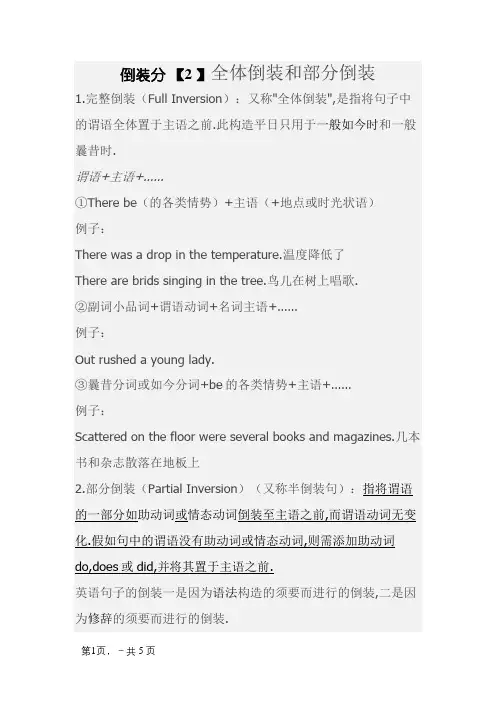
倒装分【2 】全体倒装和部分倒装1.完整倒装(Full Inversion):又称"全体倒装",是指将句子中的谓语全体置于主语之前.此构造平日只用于一般如今时和一般曩昔时.谓语+主语+……①There be(的各类情势)+主语(+地点或时光状语)例子:There was a drop in the temperature.温度降低了There are brids singing in the tree.鸟儿在树上唱歌.②副词小品词+谓语动词+名词主语+……例子:Out rushed a young lady.③曩昔分词或如今分词+be的各类情势+主语+……例子:Scattered on the floor were several books and magazines.几本书和杂志散落在地板上2.部分倒装(Partial Inversion)(又称半倒装句):指将谓语的一部分如助动词或情态动词倒装至主语之前,而谓语动词无变化.假如句中的谓语没有助动词或情态动词,则需添加助动词do,does或did,并将其置于主语之前.英语句子的倒装一是因为语法构造的须要而进行的倒装,二是因为修辞的须要而进行的倒装.前一种情形,倒装是必须的,不然就会消失语法错误;后一种情形,倒装是选择性的,倒装与否只会产生表达后果上的差异.表示强调倒装句最凸起.最常见的修辞后果就是强调,其表现情势如下:1.only +状语或状语从句置于句首,被该状语润饰的句子用部分倒装.例子:Only in this way can you solve this problem.只有效这种办法,你才可以解决这个问题.Only after he had spoken out the word did he realize he had made a big mistake.只有当他已经说出谁人字后才意识到本身犯了个大错误.2. hardly,in no way,little,scarcely,seldom,never,no more,no longer,not,not only,no sooner,not only … (but also),not until… 等具有否认意义的词或词组位于句首,句子用部分倒装.例子:No sooner had I got home than it began to rain.我刚到家就下起了雨.Seldom do I go to work by bus.我很少乘公共汽车上班.Not until twelve o'clock did she go to bed last night .她昨晚十二点才上床睡觉.3. so / such...that构造中的so或such位于句首可以组成部分倒装句,表示强调so /such和that之间的部分.例子:So unreasonable was his price that everybody startled.他的要价太离谱,令每小我都瞠目结舌.上句用倒装语序凸起了句首成分,其语气较天然语序强烈,因而具有极佳的修辞后果.4.某些副词开首的句子组成的完整倒装here.there.now.then.thus等副词开首的句子可组成完整倒装.前提是谓语动词是不及物动词,如e.exist.go.follow 等.须要留意的是,当主语是代词时,不能组成倒装.(方位词在句首,主语是名词,全体倒装)例子:Here comes our headmaster.我们的校长来了.Here it is. 在这里.Here is your key.这是你的钥匙.承上启下1.为了避免句子部分内容不必要的反复,常用"so+be动词(助动词.情态动词)+主语"或"neither/nor + be动词(助动词.情态动词)+主语"的倒装句式.个中第一个句式表示"与前面所述的确定情形雷同",第二个句式表示"与前面所述的否认情形雷同".例子:A:His brother is(not) a college student; B:so is mine.(nor is mine .)A:他弟弟(不)是大学生,B:我弟弟也是.(我弟弟也不是.)A:He used to have his further study abroad; B:so didI.(neither did I.)A:他曾去国外深造过.B:我也去过.(我也没有.)可以归纳综合成:主语雷同不倒装,主语不同倒装.英语修辞的一个主要原则是尾重原则,即把句子最庞杂的成分放在句尾以保持句子均衡.在说话应用中为了避免产生头重脚轻.构造不均衡的句子,我们常采用倒装语序.1. 以作状语的介词短语开首:当主语较长或主语所带润饰语较长时,为了使句子均衡,常将状语置于句首,句子用完整倒装语序. A. On the ground lay some air conditioners,which are to be shipped to some other cities.B. Some air conditioners lay on the ground,which are to be shipped to some other cities.地上放着一些空调,等着用船运到其他城市去.例句(1)包含一个非限制性定语从句,B句未倒装,则从句的先行词与引诱词which中央被状语分离隔,不易于懂得,而A句倒装使得先行词air conditioner与引诱词which的关系一目了然.从例句中可看出,采用倒装语序的A句构造均衡稳妥,读起来天然流利,而采用天然语序的B句构造零乱,读起来也别扭.因而,在主语较长时就应采用倒装语序以取得幻想的表达后果.2. 以表语开首的句子:有时为了把较长的主语放在后面,须将表语和谓语都提到主语前.例子:Such would be our home in the future.我们家就将是这个样子.3. 以副词here,there开首的句子,也采用完整倒装来保持句子均衡.例子:Here is the letter you have been looking forward to.你希望已久的信在这儿。
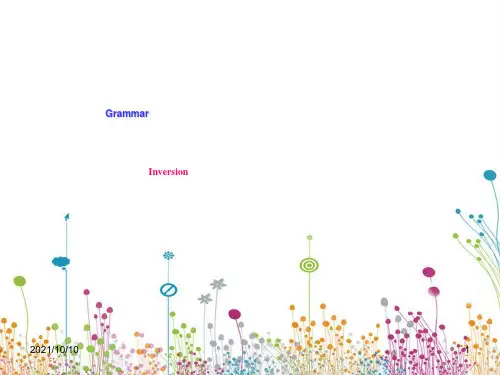
全部倒装和局部倒装英语最根本词序“主语局部+谓语局部〞通常十分固定。
如果把谓语动词放在主语前面,这就叫做倒装。
将谓语动词完全移至主语之前,称为完全倒装;如果只是把助动词或情态动词放在主语之前,称为局部倒装。
一、全部倒装1.以here, there,now,then开头的句子,谓语动词要放在句子主语之前。
这种句子谓语动词常是不及物动Here comes the train!There goes the bell!注意:如果句子的主语是人称代词,那么不能使用倒装构造。
Here it comes!There it goes!2.有些动词短语以副词out,in,up,down,away结尾,构成不及物动词短语。
为了使句子更形象,常将这些副词提前到句首。
句中的谓语动词要放在句子主语的前面,构成全部倒装。
〔注意,句子主语是名词。
如果是人称代词,不能用倒装构造。
〕Up went the rocket. Up it went.3.为了强调表示地点的介词短语,常将这个介词短语放在句首,构成全部倒装。
注意,这时句子的谓语动词通常是不及物动词。
In the front of the lecture hall sat the speaker.4.表语置于句首,且主语较长或构造较复杂的句子要用全部倒装。
/neither/nor表示前面所说的情况也适合于后者,其倒装构造为“so/neither/nor+助动词/系动词/情态动词+主语〞〔so表示肯定意义,neither/nor表示否认意义〕。
She has finished her homework,so has her brother. She ha sn’t gone there,neither/nor has he.但如果so表强调,即强调前面所说的情况的真实性时,其构造是“so+主语+助动词/系动词/情态动词〞,主语同前一个句子的主语指的是同一人或物。
She knows little English,so she does.二.局部倒装1.用于疑问句中。
倒装句详解概念:用以表示一定句子结构的需要和强调某一句子成分的需要,分为完全倒装和部分倒装。
一.完全倒装:句子中的谓语动词全部置于主语之前.此结构通常只用与一般现在时和一般过去时。
1.以here, there, now, then等副词或 out, in, up, down, away等表示运动方向的副词或地点状语置于句首以示强调,句子要全部倒装, 谓语动词常用come,go, be, lie,run,rush等.2. 表示地点的介词短语位于句首时A beautiful lake lies at the foot of the hillAt the foot of the hill lies a beautiful lake。
注意:在上述句子中, 如果主语为人称代词, 则主、谓不需要倒装。
In he came and back he went again.Away he went .二.部分倒装:be/助动词/情态动词提前到主语的前面.Is am are was were(be动词)do does did(助动词) can could would may will might(情态动词)等1。
only所修饰的副词、介词短语或状语从句放在句首时,要进行部分倒装.Only then did I realize the importance of learning English.Only after he came back was I able to see him。
注:only修饰主语,仍用自然语序,如:Only socialism can save China.I seldom go to the cinema。
倒装:Seldom do I go to the cinema.我很少去看电影.I have never seen such a performance。
倒装:Never have I seen such a performance。
倒装句倒装句(Inversion)英语的基本句型是主语+ 谓语。
如果将主语与谓语调换, 称倒装句。
倒装句分全倒装句和半倒装句。
一、全倒装: 主语与谓语交换位置不需任何助动词, 叫全倒装。
全倒装有以下三种情况:1、当here, there, out, in, up, down等副词放在句首时, 句子需全倒装:There goes the bell! 铃响了!There lived an old man.Here comes the bus.注意:①在这种情况下倒装仅限于不及物动词或be动词, 像go, come,rush等。
②主语如果是代词时不需倒装如Away he went. 他走远了。
2、方位状语在句首, 如:In front of the house stopped a police car.Nearby were two canoes in which they had come to the island.Under the tree sat a boy.3 、直接引语在句首, 这种情况可倒装也可不倒装"What does it mean?" asked the boy或the boy asked.二、半倒装: 主语与谓语的助动词交换位置称半倒装, 有以下数种情况:1、否定意义的词在句首, 句子半倒装, 例如: little, never, not, no, hardly, rarely, no moreseldomNever shall I forget you.At no time was the man aware of what was happening.Little did I understand what he said to me at that time.2、几对并列连词如not only…but also, hardly… when等连接两个并列句, 连词在句首, 前句半倒装, 后句不倒装:Not only was everything he had taker away from him, but also his Germancitizenship was taken away.No sooner had I got to the bus stop than the bus started.A.came the hour B.the hour cameC.comes the hour D.the hour is coming5、Only when he started to explain the reason for this.A.she realized B.did she realizeC.she had realized D.had she realized6、 succeed in doing anything.A.Only by working hard we canB.By only working hard we canC.Only by working hard can weD.Only we can by working hard7、Not for a moment the truth of your story.A.he has doubted B.he doubtsC.did he doubt D.he did doubt8、Nowhere else in the world cheaper tailoring than in Hong Kong. A.a tourist can find B.can a tourist findC.a tourist will find D.a tourist has found9、Hardly when the bus suddenly pulled away.A.they had got to the bus-stop B.they got to the bus-stopC.did they get to the bus-stop D.had they got to the bus -stop 10、Mary doesn’t speak French, and does Joan.A.not B.neither C.either D.so 11、—Do you know Jim quarreled with his brother? —I don’t know,. A.nor don’t I care B.nor do I careC.I don’t care neither D.I don’t care also12、Not until the early years of the 19th century what heat is.A.man did know B.man knewC.didn’t man know D.did man know13、After that we never saw her again nor from her.A.did we hear B.we heardC.had we heard D.we have heard14、John won the first prize in the contest. .A.So he did. B.So did he.C.So he did, too. D.So did he, too.15、,he doesn’t study well.A.As he is clever B.He is as cleverC.Clever as he is D.As clever he is16、You can never use my tape recorder. time should you touch that machine. A.At no B.At any C.Any D.No17、Scarcely the room the phone rang.A.I had entered…when B.Had I entered…thenC.had I entered…when D.have I entered…when18、Only save his life.A.can the doctor B.the doctor canC.will the doctor D.could the doctor19、Hardly anybody the boy , because he is rude.A.does like B.likes C.do like D.like20、So well that the teacher praised her.A.she had done her homeworkB.her homework had been doneC.did she do her homeworkD.she did her homework21、Only when to know him will you get along with him.A.do you come B.will you comeC.you come D.you will come22、Out , gun in hand.A.did he rush B.rushed heC.he rushed D.had he rushed23、He had promised me to come to the party ,and .A.so did he B.so he did C.so he would D.so would he 24、Into the sky the light blue smoke.A.went up B.up went C.did go up D.had gone up 25、Little about his own life at the meeting.A.did he talk B.he talkedC.he was talking D.had he talked26、Under no circumstances first use nuclear weapons.A.will China B.China will C.does China D.do China27、 taken that examination, she could have passed it .A.Were she B.Had she be able toC.If she would have D.Had she28、tomorrow , we would put off the match till next Monday.A.Should it rained B.Were it to rainC.If it would rain D.Had it rained29、Look, here .A.Mr. Brown comes B.does Mr. Brown comeC.comes Mr. Brown D.Mr. Brown has come30、Often us good advice.A.did she give B.she did giveC.she gave D.she has given31、Not until I began to work how much time I had wasted.A.didn’t I realize B.did I realizeC.I didn’t realize D.I realize32、Little about his own safety , though he was in great danger himself.A.does he care B.did he careC.he cares D.he cared33、began our new lesson.A.But B.Thus C.Such D.So that34、By no means look down upon the poor.A.we should B.we should notC.do we D.should we35、Only when 30 years old to learn English.A.was he , did he begin B.he was , he beganC.was he , he began D.he was ,did he begin36、Not once their plan.A.did they change B.they changedC.changed they D.they did changed37、“It’s very hot today.”“.”A.So it is B.So is it C.So does it D.So it does 38、A fish needs water and without water it will die.A.So does a man B.So will a manC.So it is with a man D.So is it with a man39、They arrived at the farmhouse, in front of which .A.sat a small boy B.a small boy satC.is sitting a small boy D.a small boy sitting40、Society has changed and in it .A.so have the people B.so the people haveC.the people have so D.have the people soⅡ、改错41、Only when was he 50 years old did he begin to learn French.42、Little she knew Tom was was badly ill43、Turn to the right and there are you.44、And all around the fox in a circle was dogs.45、—You can learn English well.—So can we.46、I dare climb this tall tree, but do you?47、Not once he kept his promise.48、Many a time he has given us some good advice.49、Such a noise there was that I couldn’t work in the room.50、Only does my mother understand me.【答案】:Ⅰ、1、B2、C3、A4、A5、B6、C7、C8、B9、D 10、B 11、B 12、D13、A 14、A 15、C 16、A 17、C 18、B19、B 20、C 21、C 22、C 23、B 24、A25、A 26、A 27、D 28、B 29、C 30、A31、B 32、B 33、B 34、D 35、D 36、A37、A 38、C 39、A 40、AⅡ、41、was he —he was 倒装主句不倒装从句。
倒装【知识简介】一般陈述句结构为“主语+谓语”,如果将句子某一部分移到句子前面而引起主语和谓语的顺序颠倒就成了倒装。
疑问句一般均为倒装,但我们这里将不予讨论。
倒装有两种情况:全部倒装(提前部分+谓语动词+主语)和部分倒装(提前部分+助动词/be动词/情态动词+主语)。
【要点难点】1. 全部倒装①here, there, now, then等副词置于句首时用全倒装形式,这种句型常用来强调或提醒一个正在进行的动作,但谓语动词多为一般现在时形式(有时也用一般过去时)。
Here are the tools. 工具在这儿。
Now comes your turn. 现在轮到你了。
There goes the bell. 铃响了。
There entered a strange little man. 走进来一个奇怪而身村又矮小的人。
Once there lived an old fisherman in a village by the sea. 从前,海边的一个村子里住着一位老渔夫。
Then came Mary and George. 然后玛丽和乔治来了。
注意:如果主语为人称代词,则主谓不能倒装。
—Where’s my dictionary? 我的词典在哪里?—Here it is. 给。
(不说Here is it.)②表示位置或时间的副词如away, up, down, in, out, next, soon等,句子用全倒装形式。
在这种句型中,谓语动词往往是be动词及come, go, fall, fly, lie等趋向动词。
Down came the rain. 下雨了。
Up went the arrow into the air. 飕地一声,箭射上了天。
Away went the boy to the school! 那男孩子到学校里去了!In came our English teacher, with a dictionary in his hand. 英语老师走了进来,手里拿着本词典。
英语的倒装句整理归纳英语倒装句句型的结构有两种:部分倒装和完全倒装。
一、部分倒装部分倒装其实也很简单,我们只需要记住,它完全和疑问句结构一样,要把谓语的一部分(即系动词be;助动词do, have,be, will;情态动词can, must should等)提到主语之前。
Not only is he humorous, but he is also kind to the kids.他不仅幽默,而且对孩子们也很好。
Seldom does the boy eat lamb.这个男孩很少吃羊肉。
Little can we do to help the poor man.我们帮不了这个可怜的人。
部分倒装具体情况:1,否定词never及部分否定词rarely和seldom在句首:Never have I been felt so frustrated!我从来没有这么沮丧过!Seldom has she done anything more foolish.她很少干过比这更愚蠢的事。
注意,句子中往往是完成时态且可能含有比较级。
2,部分否定词hardly, barely, no sooner, or scarcely在句首:No sooner had she got in the bath than the doorbell rang.她刚开始洗澡,门铃响了。
No sooner had we reach the bus station than the bus came.我们一到公共汽车站,公共汽车就来了。
Barely had I closed the door when the phone rang.我刚关上门,电话就响了。
注意,这类句子中一般有先后接连发生的两个动作。
所以从主句多用过去完成时。
3, 部分否定词Little在句首:Little have I read about archeology.我很少读考古学方面的东西。
倒装1.定义:在英语中,主语和谓语的语序通常是主语在前,谓语在后。
但有时谓语的全部或者一部分(通常是助动词或情态动词)却提到主语的前面,这种语序叫做“倒装”。
2.分类:全部倒装和部分倒装;3.全部倒装:把谓语全部提到主语之前,即…… + 谓语+ 主语(1)用于there be 句型;e.g. There are many students in the classroom.(2)There be 结构。
在此结构中可以用exist, lie, live, stand 等代替be。
e.g. There stood a dog before him.(3) 在以here, there, now, then等副词开头的句子里, 谓语动词常为be, come, go等。
e.g. Here comes the old lady!Then followed another shot of gun.(4)表示方向的副词out, in, up, down, away, off 等置于句首,要用全部倒装。
e.g. Off went the car.The door opened and in came Mrs. Smith.On hearing the shot, away flew the bird.(5)注意:如果主语是人称代词则不用倒装。
e.g. The door opened and in she came.Here it comes.On hearing the shot, away it flew.(6)当表示地点的副词(如inside,outside等)、介词词组(如on the wall, west of the house等)在句首时。
e.g. East of the lake lie two towns.Inside was an exhibition of the most up- to-date inventions of the 31st century.(7)直接引语的一部分或全部放在句首时,有时也用倒装。